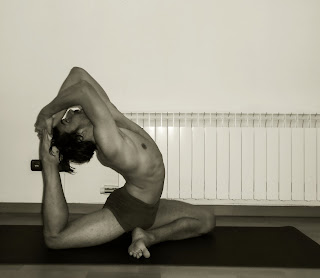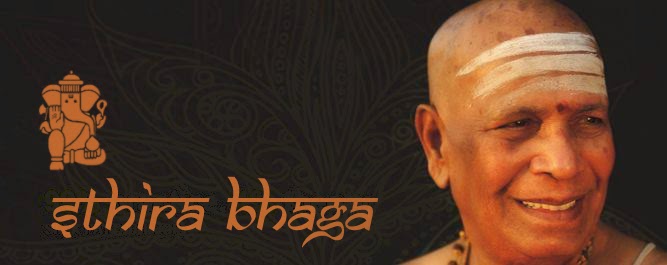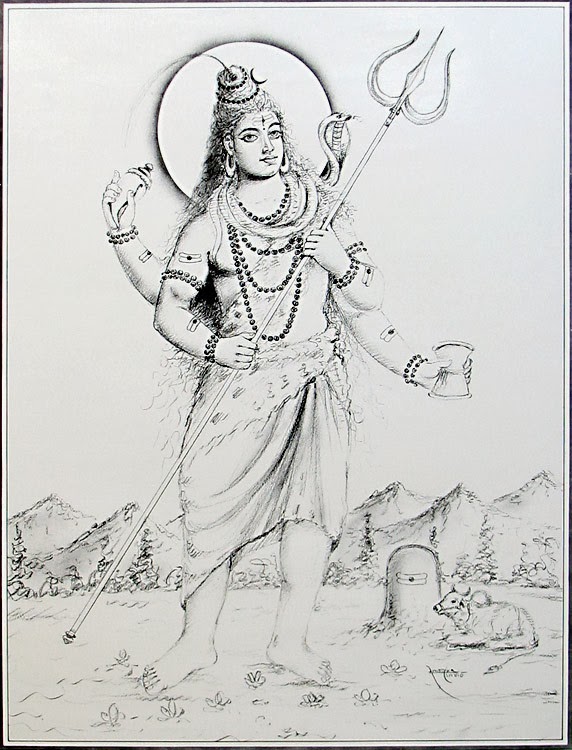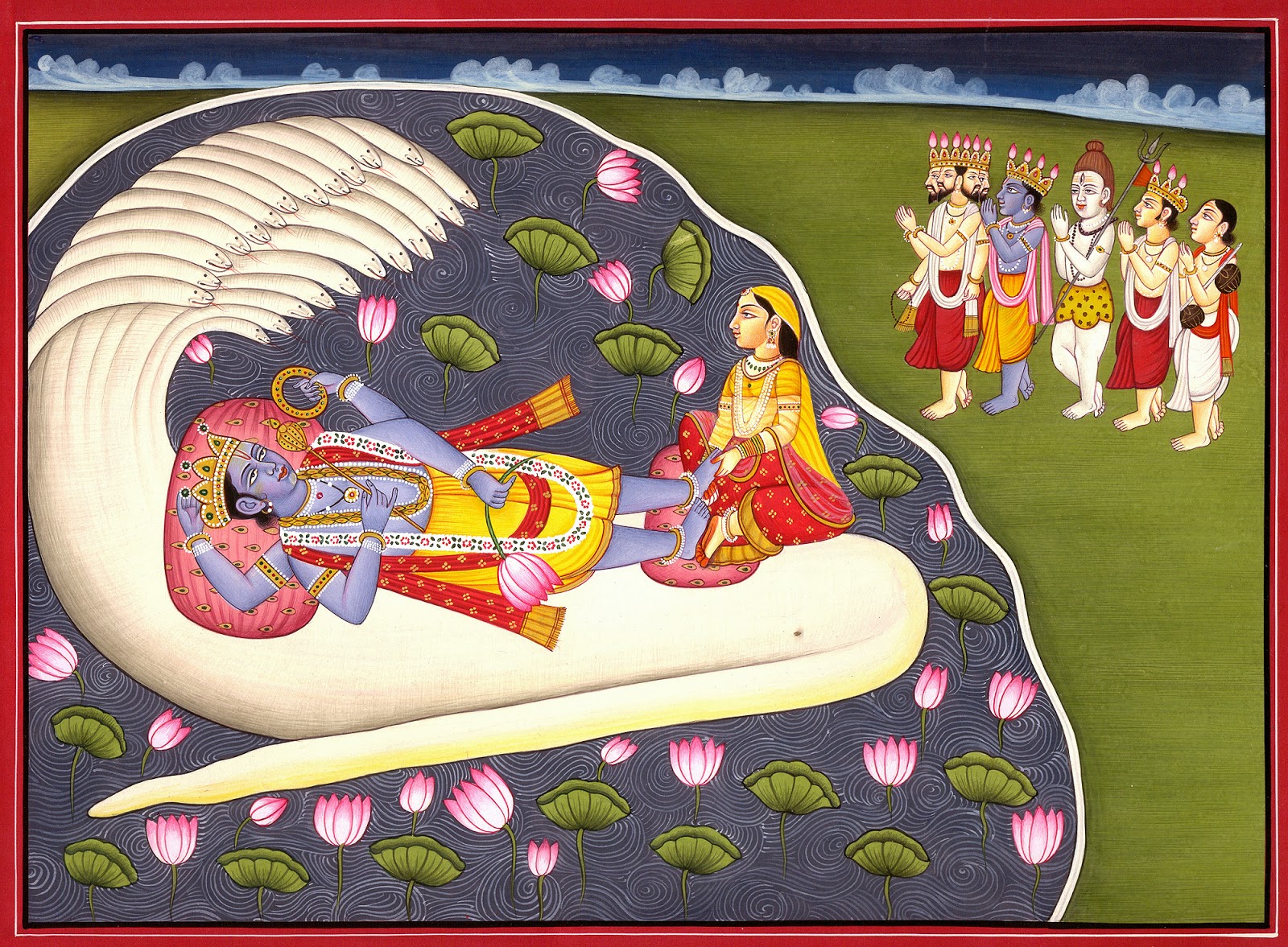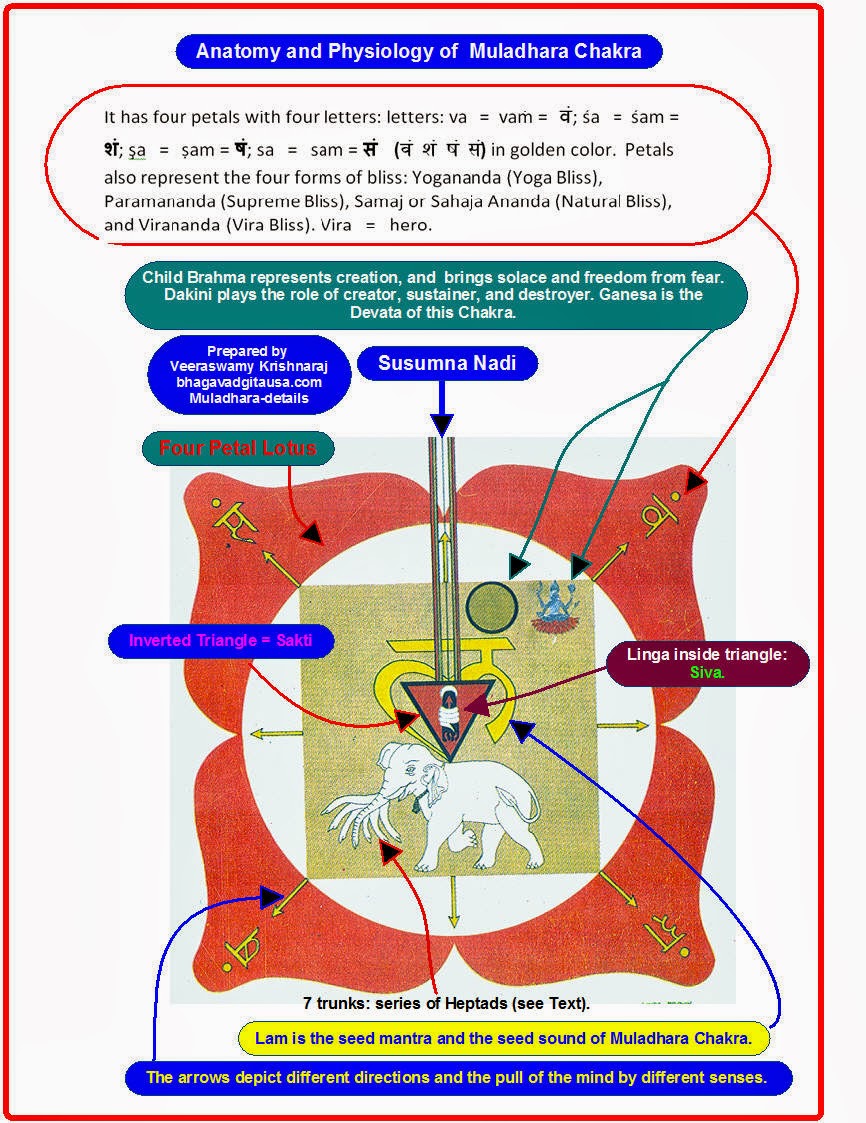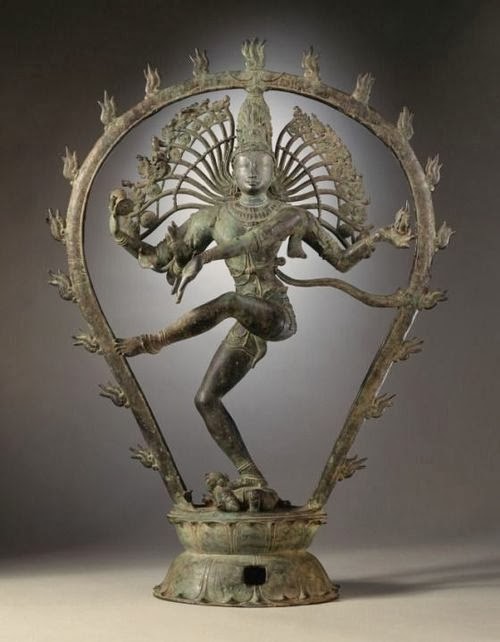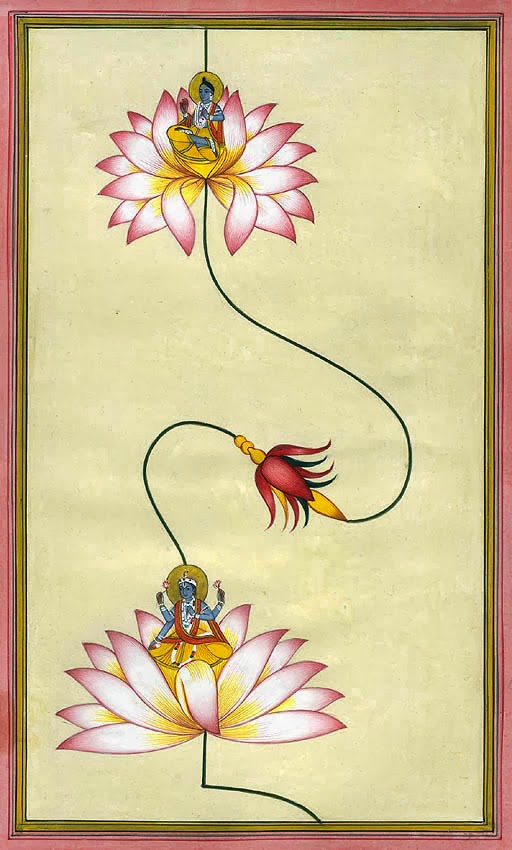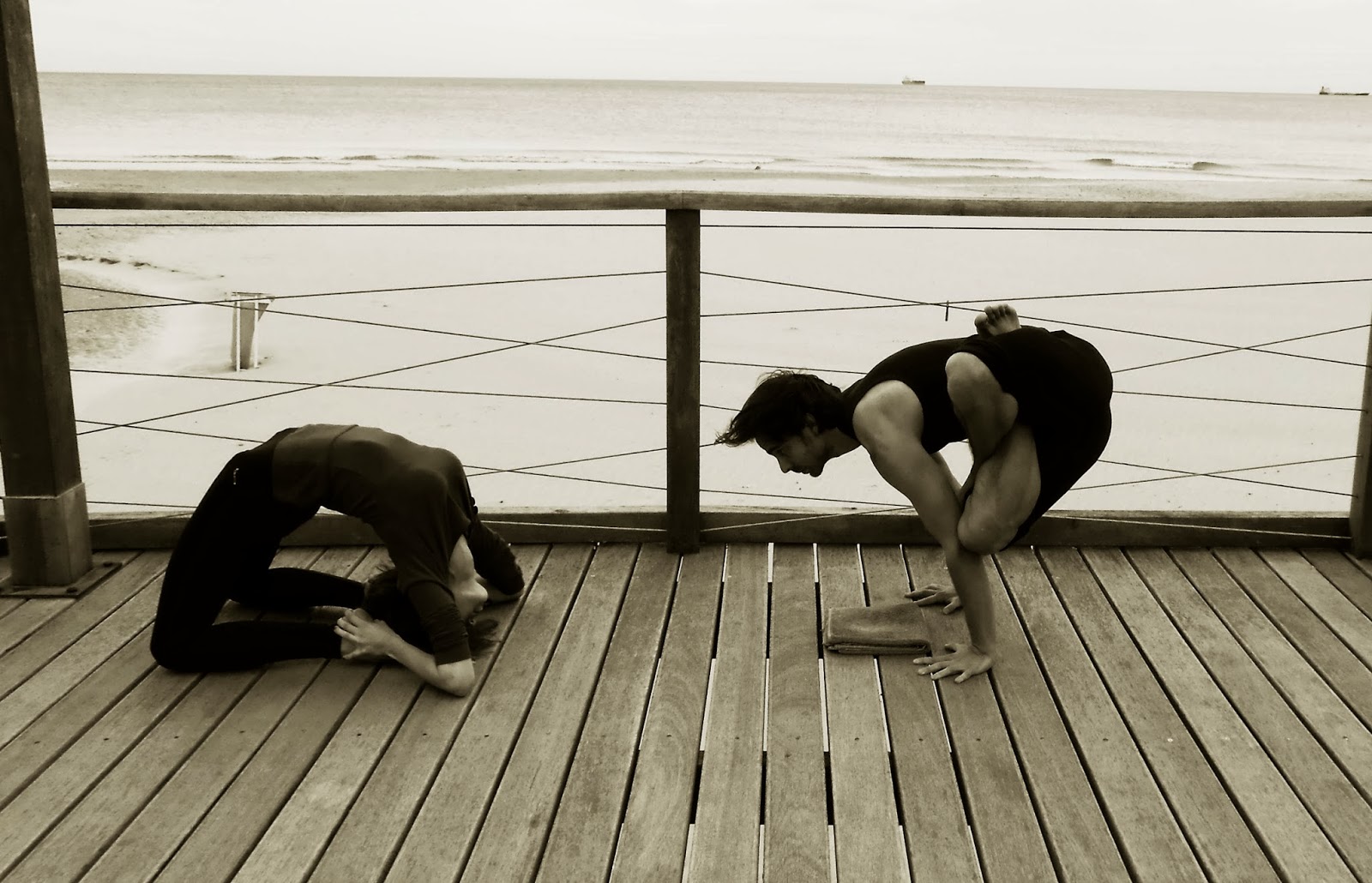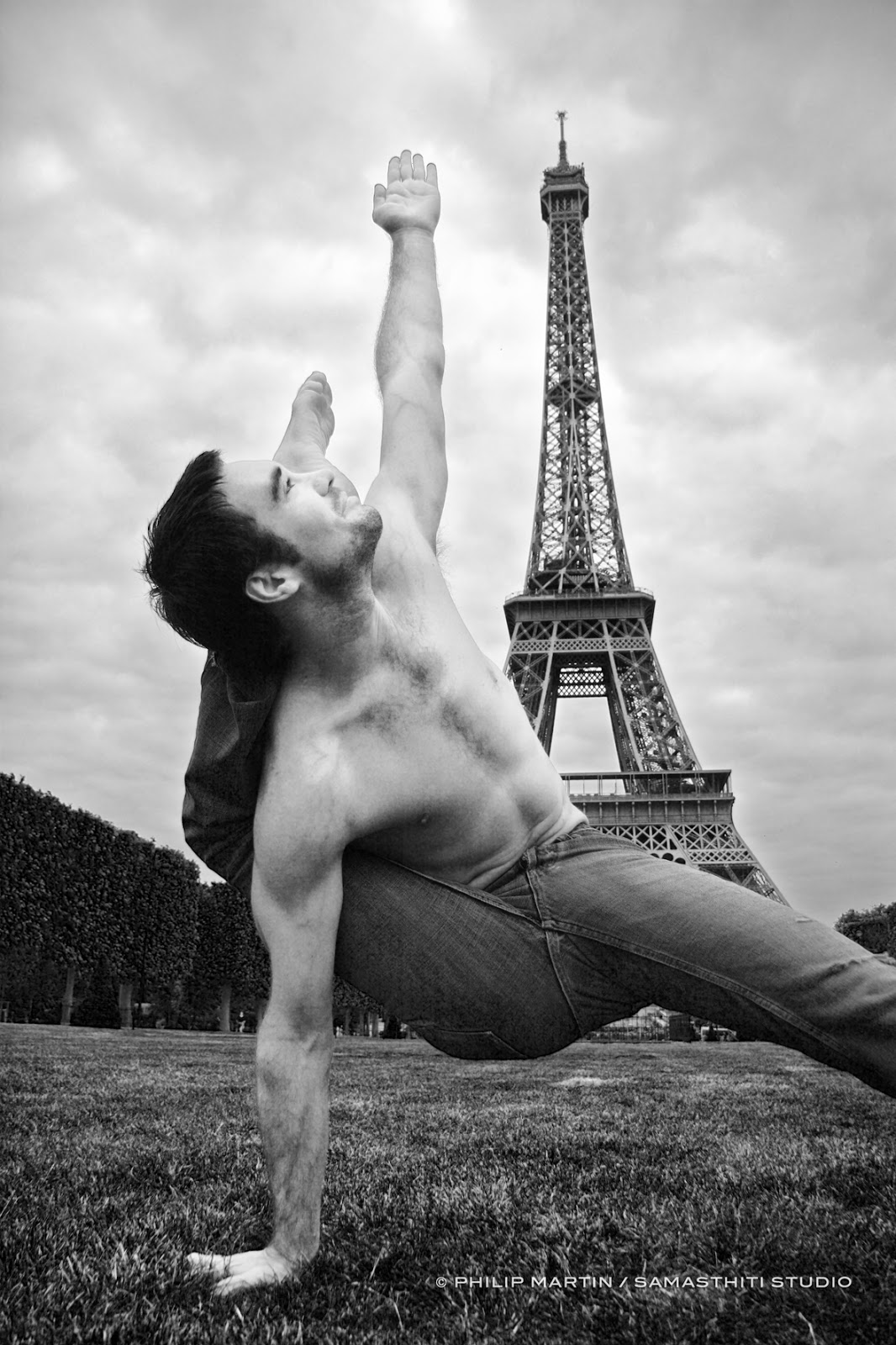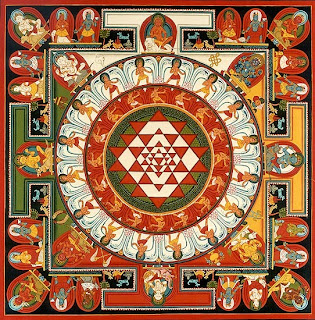
28. In the throat is the Lotus called Vishuddha, which is pure and of a smoky purple hue. All the
(sixteen) shining vowels on its (sixteen) petals, of a crimson hue, are distinctly visible to him
whose mind (Buddhi) is illumined. In the pericarp of this lotus there is the Ethereal Region,
circular in shape, and white like the full Moon. On an elephant white as snow is seated the Bija
of Ambara, who is white of colour.
Moon = Mantra = here, "ham"
Ambara = the Ethereal Region
29. Of his Four arms, two hold the noose and goad, and the other two make the gestures of
granting boons and dispelling fear. These add to His beauty. In His lap there ever dwells the
great snow-white Deva, three-eyed and five-faced, with ten beautiful arms, and clothed in a
tiger's skin. His body is united with that of Girija, and He is known by what His name, Sadha-
Shiva, signifies.
Noose = pasa
Goad = Ankusa
Gestures = mudras
Girija = mountain-born
Sada-Shiva = ever-beneficent
30. Purer than the Ocean of Nectar is the Shakti Shakini who dwells in this Lotus. Her raiment is
yellow, and in Her four lotus-hands She carries the bow, the arrow, the noose, and the goad. The
whole region of the Moon without the mark of the hare is in the pericarp of this Lotus. This
(region) is the gateway of great Liberation for him who desires the wealth of Yoga and whose
senses are pure and controlled.
Mark of the hare = man in the moon.
31. He who has attained complete knowledge of the Atma (Brahman) becomes by constantly
concentrating his mind (Citta) on this Lotus a great Sage, eloquent and wise, and enjoys
uninterrupted peace of mind. He sees the three periods, and becomes the benefactor of all, free
from disease and sorrows and long-lived, and, like Hamsa, the destroyer of endless dangers.
Sage = kavi
Three periods = past, present, and
future.
31a. The Yogi, his mind constantly fixed on this Lotus, his breath controlled by Kumbhaka, is in
his wrath able to move all the three worlds. Neither Brahma nor Vishnu, neither Hari-Hara nor
Surya nor Ganapa is able to control his power (resist him).
The translator has numbered this verse
"31a" because it does not appear in the
texts used by two of the three
commentators on whom he relies.
Kumbhaka = retention of breath in
pranayama
Ganapa = Ganesha
32. The Lotus named Ajna is like the Moon, (beautifully white). On its two petals are the letters Ha
and Ksa, which are also white and enhance its beauty. It shines with the glory of Dhyana. Inside it is
the Shakti Hakini, whose six faces are like so many moons. She has six arms, in one of which She
holds a book; two others are lifted up in the gestures of dispelling fear and granting boons, and with
the rest She holds a skull, a small drum, and a rosary. Her mind is pure (Suddha-Citta).
Ajna = lit., command
holds a book: the meaning is that
she is making the mudra called
vidya or pustaka, not that she is
actually holding a book
Small drum = damaru
33. Within this Lotus dwells the subtle mind (Manas). It is well-known. Inside the Yoni in the
pericarp is the Shiva called Itara, in His phallic form. He here shines like a chain of lightning flashes.
The first Bija of the Vedas, which is the abode of the most excellent Shakti and which by its lustre
makes visible the Brahma-sutra, is also there. The Sadhaka with steady mind should meditate upon
these according to the order (prescribed).
Itara = that which enables one to
cross Lala.
First bija of the Vedas = Om.
Brahma-sutra = the nadi-chitrini.
34. The excellent Sadhaka, whose Atma is nothing but a meditation on this Lotus, is able quickly to
enter another's body at will, and becomes the most excellent among Munis, and all-knowing and allseeing.
He becomes the benefactor of all, and versed in all the Sastras. He realizes his unity with the
Brahman and acquires excellent and unknown powers. Full of fame and long-lived, he ever becomes
the Creator, Destroyer, and Preserver, of the three worlds.
Another's body = para-pura; may
also mean "another's house."
Powers = siddhi.
35. Within the triangle in this Chakra ever dwells the combination of letters which form the Pranava.
It is the inner Atma as pure mind (Buddhi), and resembles a flame in its radiance. Above it is the half
(crescent) moon, and above this, again, is Ma-kara, shining in its form of Bindu. Above this is Nada,
whose whiteness equals that of Balarama and diffuses the rays of the Moon.
Pranava = the word "Om."
Combination of letters = A and U,
i.e., the vowels in the word "aum."
Ma-kara = the letter M in its bindu
form in candra-bindu.
Nada = the half-moon symbol.
36. When the Yogi closes the house which hangs without support, the knowledge whereof he has
gained by the service of Parama-guru, and when the Cetas by repeated practice becomes dissolved in
this place which is the abode of uninterrupted bliss, he then sees within the middle of and in the space
above (the triangle) sparks of fire distinctly shining.
Closes the house = make the
yoni-mudra, which detaches the
inner self (antah-pur) and mind
(manas) from the empirical world.
37. He then also sees the Light which is in the form of a flaming lamp. It is lustrous like the clearly
shining morning sun, and glows between the Sky and the Earth. It is here that the Bhagavan manifests
Himself in the fullness of His might. He knows no decay, and witnesseth all, and is here as He is in
the region of Fire, Moon, and Sun.
Light = djoti.
Sky = gagana = empty space
above Sankhini-nadi.
Earth = dharani = dhara-mandala
in the muladhara.
Region of Fire, Moon, and Sun =
the triangle on Manipitha within
the A-ka-tha triangle.
38. This is the incomparable and delightful abode of Vishnu. The excellent Yogi at the time of death
joyfully places his vital breath (Prana) here and enters (after death) that Supreme, Eternal, Birthless,
Primeval Deva, the Purusha, who was before the three worlds, and who is known by the Vedanta.
39. When the actions of the Yogi are, through the service of the Lotus feet of his Guru, in all
respects good, then he will see above it (i.e., Ajna-chakra) the form of the Mahanada, and will
ever hold in the Lotus of his hand the Siddhi of Speech. The Mahanada, which is the place of
dissolution of Vayu is the half of Shiva, and like the plough in shape, is tranquil and grants boons
and dispels fear, and makes manifest pure Intelligence (Buddhi).
Half of Shiva: the meaning is that Shiva
is Hakara; if the upper part of Ha is
removed, the remaining portion of the
letter has the form ofan Indian plough.
Mahanada = Maha-nada
40. Above all these, in the vacant space wherein is Sankhini Nadi, and below Visarga is the Lotus
of a thousand petals. This Lotus, lustrous and whiter than the full Moon, has its head turned
downward. It charms. Its clustered filaments are tinged with the colour of the young Sun. Its
body is luminous with the letters beginning with A, and it is the absolute bliss.
Vacant space: elsewhere called the
parama-vyoma = supreme ether.
Lotus of a thousand petals = Sahasrara
Absolute bliss = kevalananda-rupam =
lit., Brahman bliss
41. Within it (Sahasrara) is the full Moon, without the mark of the hare, resplendent as in a clear
sky. It sheds its rays in profusion, and is moist and cool like nectar. Inside it (Candra-mandala),
constantly shining like lightning, is the Triangle and inside this, again, shines the Great Void
which is served in secret by all the Suras.
Mark of the hare = the man in the moon.
Triangle = the A-ka-thadi triangle.
Great Void = sunya = bindu.
Suras = devas.
42. Well concealed, and attainable only by great effort, is that subtle Bindu (Sunya) which is the
chief root of Liberation and which manifests the pure Nirvana-Kala with Ama-Kala. Here is the
Deva who is known to all as Parama-Shiva. He is the Brahman and the Atma of all beings. In
Him are united both Rasa and Virasa, and He is the Sun which destroys the darkness of nescience
and delusion.
Nirvana-Kala and Ama-Kala: There are
seventeen Kalas (digits) of the moon,
but the nectar-dropping Ama and the
Nirvana-kala are only at this stage
revealed.
Rasa and Virasa = the bliss of liberation
and that arising from the union of Shiva
and Shakti.
Nescience = ajnana.
Delusion = moha.
43. By shedding a constant and profuse stream of nectar-like essence, the Bhagavan instructs the
Yati of pure mind in the knowledge by which he realizes the oneness of the Jivatma and the
Paramatma. He pervades all things as their Lord, who is the ever-flowing and spreading current
of all manner of bliss known by the name of Hamsah Parama (Parama-hamsah).
Yati = someone whose mind rests
intently upon the Devata of his worship.
44. The Shaivas call it the abode of Shiva; the Vaisnavas call it Parama Purusha; others again,
call it the place of Hari-Hara. Those who are filled with a passion for the Lotus feet of the Devi
call it the excellent abode of the Devi; and other great sages (Munis) call it the pure place of
Prakriti-Purusha.
Shaivas = worshippers of Shiva.
Vaisnavas = worshippers of Vishnu.
Hari-Hara = Vishnu and Shiva.
Devi = Shakti.
Prakriti-Purusha = Shakti-Shiva.
45. That most excellent of men who has controlled his mind and known this place is never again
born in the Wandering, as there is nothing in the three worlds which binds him. His mind being
controlled and his aim achieved, he possesses complete power to do all which he wishes, and to
prevent that which is contrary to his will. He ever moves towards the Brahman. His speech,
whether in prose or verse, is ever pure and sweet.
Mind = citta.
Wandering = samsara.
Brahman = lit. kha, which could also
mean "air" or "ether."
46. Here is the excellent (supreme) sixteenth Kala of the Moon. She is pure, and resembles (in
colour) the young Sun. She is as thin as the hundredth part of a fibre in the stalk of a lotus. She is
lustrous and soft like ten million lightning flashes, and is down-turned. From Her, whose source
is the Brahman, flows copiously the continuous stream of nectar (or, She is the receptacle of the
stream of excellent nectar which comes from the blissful union of Para and Parama).
Para and Parama = bindu-rupa Shiva
and Shakti.
47. Inside it (Ama-kala) is Nirvana-kala, more excellent than the excellent. She is as subtle as the
thousandth part of the end of a hair, and of the shape of the crescent moon. She is the everexistent
Bhagavati, who is the Devata who pervades all beings. She grants divine knowledge, and
is as lustrous as the light of all the suns shining at one and the same time.
48. Within its middle space (i.e., middle of the Nirvana-kala) shines the Supreme and Primordial
Nirvana-Shakti; She is lustrous like ten million suns, and is the Mother of the three worlds. She is
extremely subtle, and like unto the ten-millionth part of the end of a hair. She contains within Her
the constantly flowing stream of gladness, and is the life of all beings. She graciously carries the
knowledge of the Truth (Tattva) to the mind of the sages.
Nirvana-Shakti = Samanapada or
Samani Shakti.
Stream of gladness = Prema.
49. Within Her is the everlasting place called the abode of Shiva, which is free from Maya,
attainable only by Yogis, and known by the name of Nityananda. It is replete with every form of
bliss, and is pure knowledge itself. Some call it the Brahman; others call it Hamsa. Wise men
describe it as the abode of Vishnu, and righteous men speak of it as the ineffable place of
knowledge of the Atma, or the place of Liberation.
Abode of Shiva = Shiva-padam = state
of Shiva.
Pure knowledge itself = suddha-bodhasvarupam.
Righteous men = sukritinah.
Sat chakra nirupana By Purnananda Swami part one (1/4)
Sat chakra nirupana By Purnananda Swami part two (2/4)
Sat chakra nirupana By Purnananda Swami part Four (4/4)
